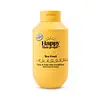What's inside
What's inside
 Key Ingredients
Key Ingredients

No key ingredients
 Benefits
Benefits

 Concerns
Concerns

No concerns
 Ingredients Side-by-side
Ingredients Side-by-side

Rosmarinus Officinalis Leaf Extract 99%
AntimicrobialPinus Densiflora Leaf Extract
AntimicrobialGlycerin
HumectantCaprylic/Capric Triglyceride
MaskingCetyl Alcohol
EmollientBehentrimonium Methosulfate
Stearyl Alcohol
EmollientBetaine
HumectantBifida Ferment Lysate
Skin ConditioningLactobacillus Ferment Lysate
Skin ConditioningBiotin
AntiseborrhoeicPanthenol
Skin ConditioningCaffeine
Skin ConditioningChamaecyparis Obtusa Leaf Extract
Skin ConditioningRosa Rugosa Leaf Extract
HumectantTamarindus Indica Hydroxypropyltrimonium Chloride
Skin ConditioningRosmarinus Officinalis Leaf Extract 99%, Pinus Densiflora Leaf Extract, Glycerin, Caprylic/Capric Triglyceride, Cetyl Alcohol, Behentrimonium Methosulfate, Stearyl Alcohol, Betaine, Bifida Ferment Lysate, Lactobacillus Ferment Lysate, Biotin, Panthenol, Caffeine, Chamaecyparis Obtusa Leaf Extract, Rosa Rugosa Leaf Extract, Tamarindus Indica Hydroxypropyltrimonium Chloride
Water
Skin ConditioningRicinus Communis Seed Oil
MaskingCetearyl Alcohol
EmollientCocos Nucifera Oil
MaskingBehentrimonium Chloride
PreservativeGlycerin
HumectantButyrospermum Parkii Butter
Skin ConditioningCitrus Aurantium Dulcis Peel Oil
MaskingPanthenol
Skin ConditioningParfum
MaskingIsopropyl Alcohol
SolventSodium Benzoate
MaskingCitric Acid
BufferingHydroxyethylcellulose
Emulsion StabilisingPotassium Sorbate
PreservativeCitral
PerfumingCitronellol
PerfumingGeraniol
PerfumingHexyl Cinnamal
PerfumingLimonene
PerfumingWater, Ricinus Communis Seed Oil, Cetearyl Alcohol, Cocos Nucifera Oil, Behentrimonium Chloride, Glycerin, Butyrospermum Parkii Butter, Citrus Aurantium Dulcis Peel Oil, Panthenol, Parfum, Isopropyl Alcohol, Sodium Benzoate, Citric Acid, Hydroxyethylcellulose, Potassium Sorbate, Citral, Citronellol, Geraniol, Hexyl Cinnamal, Limonene
 Reviews
Reviews

Ingredients Explained
These ingredients are found in both products.
Ingredients higher up in an ingredient list are typically present in a larger amount.
Glycerin is already naturally found in your skin. It helps moisturize and protect your skin.
A study from 2016 found glycerin to be more effective as a humectant than AHAs and hyaluronic acid.
As a humectant, it helps the skin stay hydrated by pulling moisture to your skin. The low molecular weight of glycerin allows it to pull moisture into the deeper layers of your skin.
Hydrated skin improves your skin barrier; Your skin barrier helps protect against irritants and bacteria.
Glycerin has also been found to have antimicrobial and antiviral properties. Due to these properties, glycerin is often used in wound and burn treatments.
In cosmetics, glycerin is usually derived from plants such as soybean or palm. However, it can also be sourced from animals, such as tallow or animal fat.
This ingredient is organic, colorless, odorless, and non-toxic.
Glycerin is the name for this ingredient in American English. British English uses Glycerol/Glycerine.
Learn more about GlycerinPanthenol is a common ingredient that helps hydrate and soothe the skin. It is found naturally in our skin and hair.
There are two forms of panthenol: D and L.
D-panthenol is also known as dexpanthenol. Most cosmetics use dexpanthenol or a mixture of D and L-panthenol.
Panthenol is famous due to its ability to go deeper into the skin's layers. Using this ingredient has numerous pros (and no cons):
Like hyaluronic acid, panthenol is a humectant. Humectants are able to bind and hold large amounts of water to keep skin hydrated.
This ingredient works well for wound healing. It works by increasing tissue in the wound and helps close open wounds.
Once oxidized, panthenol converts to pantothenic acid. Panthothenic acid is found in all living cells.
This ingredient is also referred to as pro-vitamin B5.
Learn more about Panthenol